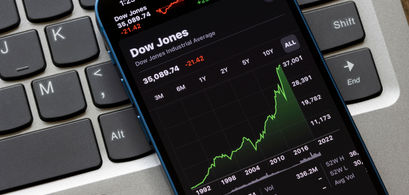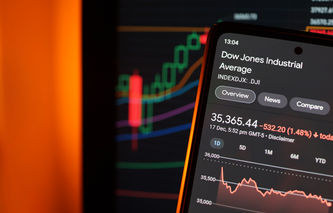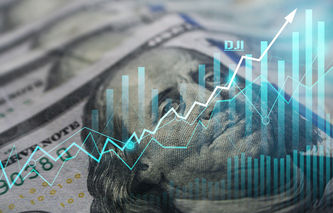No stock market report is complete without a mention of the Dow Jones Industrials. It's an average that most investors like to talk about; and an index that many use to get a feel for the direction the market is moving. Not everyone thinks it is as important as it once was, but everyone will agree that it has a rich history, and can be exciting to watch.
History of the Dow
The Dow Jones Industrial Average, or DJIA, was first published on May 26, 1896. At that time, the DJIA represented the average of only twelve stocks. Each stock was carefully selected from an important U.S. industry. Of the original twelve stocks, General Electric is the only company to stay in the Average by avoiding merger, bankruptcy; or a decision that it was no longer a good indicator of the American economy.
On the day that it was first published, the Index stood at 40.94. Back then, it wasn't really an index; the Dow was more of an average. That means it was calculated by adding up all the stock prices of the member companies, then dividing by the number of members. By 1916, the industrials had grown to include 20 different stocks, in 1928 it moved to 30; and it's been at that number ever since.
Industrial Milestones
It took 76 years for the DJIA to hit the 1,000 mark; and it went from 10,000 to 11,000 in just one month. On October 19, 2006 the Dow reached one of its more difficult milestones of 12,000, after taking seven years and five months to cross this threshold.
Many investors study the history of the Dow, hoping to learn from the mistakes of the past. Whether it's a bull or bear market, there are scores of analysts tracking the Industrial's every move, trying to figure out where it's going next.
Important dates in the history of the Dow include Black Monday. During the stock market crash of 1987, the Dow dropped 22.6% in just one day. On September 17, 2001, the first day of trading after September 11th (9/11), the Dow fell over 684 points. The stock market crash of 1929 marks another dark time for the Dow, after which it would take 22 years for the Index to reach new highs.
Components of the DJIA
As mentioned earlier, the Dow Jones Industrials is made up of 30 stocks or component companies. Each component is assigned a percentage that represents its weighting when the average or index is calculated. For example, 3M has a weight of around 3.80%. This means 3.80% of the movement in the Dow can be explained by movement in the stock of 3M.
The component weight becomes important when a stock is replaced in the Index, which does happen from time to time. By using a component weight, the Industrials can be consistently tracked after the replacement has occurred. If a component weighting was not used, the entire DJIA would have to be restated to account for the change in just one stock. The stocks of the Dow, along with their approximate component weights, appear in the following table:
Dow Jones 30 Components
Company Name | Weighting % |
3M Company | 3.80% |
American Express Company | 2.56% |
Amgen Inc. | 4.86% |
Apple Inc. | 2.88% |
Caterpillar Inc. | 3.91% |
Chevron Corporation | 1.86% |
Cisco Systems, Inc. | 0.97% |
Dow Inc. | 1.19% |
Honeywell International Inc. | 4.56% |
Intel Corporation | 1.03% |
International Business Machines Corporation | 2.72% |
Johnson & Johnson | 3.32% |
JPMorgan Chase & Co. | 2.71% |
McDonald's Corporation | 4.61% |
Merck & Co., Inc. | 1.75% |
Microsoft Corporation | 4.85% |
NIKE, Inc. | 3.08% |
salesforce.com, inc. | 4.92% |
The Boeing Company | 4.73% |
The Coca-Cola Company | 1.16% |
The Goldman Sachs Group, Inc. | 5.58% |
The Home Depot, Inc. | 5.90% |
The Procter & Gamble Company | 3.00% |
The Travelers Companies, Inc. | 3.02% |
The Walt Disney Company | 3.78% |
UnitedHealth Group Incorporated | 7.42% |
Verizon Communications Inc. | 1.28% |
Visa Inc. | 4.55% |
Walgreens Boots Alliance, Inc. | 0.86% |
Walmart Inc. | 3.13% |
A spreadsheet of this information is also available for download: Dow Jones Industrial Components. All of the DJIA member companies and weights are stated as of December 2020.
Criticism of the Industrial's Calculation
Many of today's investors criticize the DJIA because it is a price-weighted average. That means the calculation gives higher-priced stocks more influence over the average than lower-priced stocks. For those of us that are mathematically challenged, this means a $1 increase in a low priced stock of the Industrials can be negated by a $1 decrease in a higher priced stock. Many feel this is misleading as an indicator because the lower priced stock experienced a proportionally larger increase than the higher priced stock's decrease.
Finally, others feel that 30 stocks cannot reasonably be expected to represent overall market conditions or investor sentiment. This feeling has led many investors and stock market experts to rely on, and believe, the S&P 500 Index is a more realistic indicator of the market's true performance.




